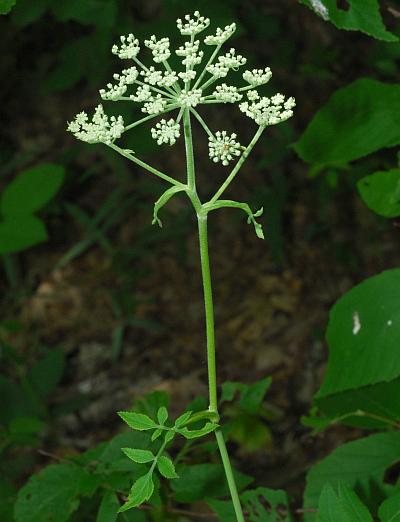Angelica venenosa (J. Greenway) Fernald
Wood Angelica

Native
CC = 8
CW = 5
MOC = 23
© SRTurner
Angelica venenosa (J. Greenway) FernaldWood Angelica | |
 |
Native CC = 8 CW = 5 MOC = 23 |
© SRTurner |
|
Family - Apiaceae Habit - Taprooted perennial forb. Stem - Ascending to erect, to 1.5 m, glabrous, sometimes glaucous.
Leaves - Alternate and sometimes also basal (1 or 2 basal leaves sometimes present at flowering), glabrous, short- to long-petiolate, the sheathing bases not or only slightly inflated, the uppermost leaves sometimes reduced to bladeless, somewhat inflated sheaths. Leaf blades to 25 cm long, triangular-ovate in outline, pinnately or ternately then pinnately 2-3 times compound, the leaflets distinct, these 15-50 mm long, mostly 10 mm or more wide, ovate or narrowly ovate to elliptic, occasionally with 1 or 2 basal lobes, narrowed or tapered at the base, bluntly or sharply pointed at the tip, finely toothed along the margins, densely short-hairy abaxially.
Inflorescence - Mostly terminal, compound umbels, long-stalked, the stalks moderately to densely short-hairy. Involucre absent. Rays 18 to numerous, 1-8 cm long, moderately to densely short-hairy. Involucel of several entire bractlets, these mostly slightly shorter than the flower stalks, linear, short-hairy
Florets - Flowers 8 to numerous in each umbellet, the stalks 2-10 mm long, hairy. Sepals absent or minute triangular teeth. Petals 5, obovate, rounded at the tip, white. Stamens 5. Pistil 1 per flower, composed of 2 fused carpels, the ovary inferior, short-hairy, with a swollen nectar disc at the tip, the styles 2.
Fruits - Schizocarps consisting of 2 mericarps, 4-6 mm long, ovate-elliptic in outline, shallowly cordate at the base, flattened dorsally, sparsely to moderately short-hairy, dark brown with usually lighter ribs. Mericarps indehiscent, 1-seeded, often somewhat flattened, with 5 more or less prominent ribs, some or all of these sometimes winged.
Flowering - May - July. Habitat - Forests, savannas, prairie edges, streambanks. Origin - Native to the U.S. Lookalikes - Other species in the family, e.g. those in the genera Cicuta, Torilis, Ligusticum, and several others. Other info. - This species is found in a well-defined band extending from Iron and Crawford Counties in Missouri, through the southwest corner of the state, and into Arkansas and Oklahoma. It is also common in the eastern U.S. It is similar in appearance to several other members of the family, but can be distinguished by its distinctly hairy inflorescences and discrete, toothed leaflets. Photographs taken at Millstream Gardens Conservation Area, Madison County, MO, 7-28-2013 and 7-4-2017, Onondaga Cave State Park, Crawford County, MO, 6-25-2014 and 7-31-2014, and along Hwy 181 in Douglas County, MO, 7-2-2020 (SRTurner). |